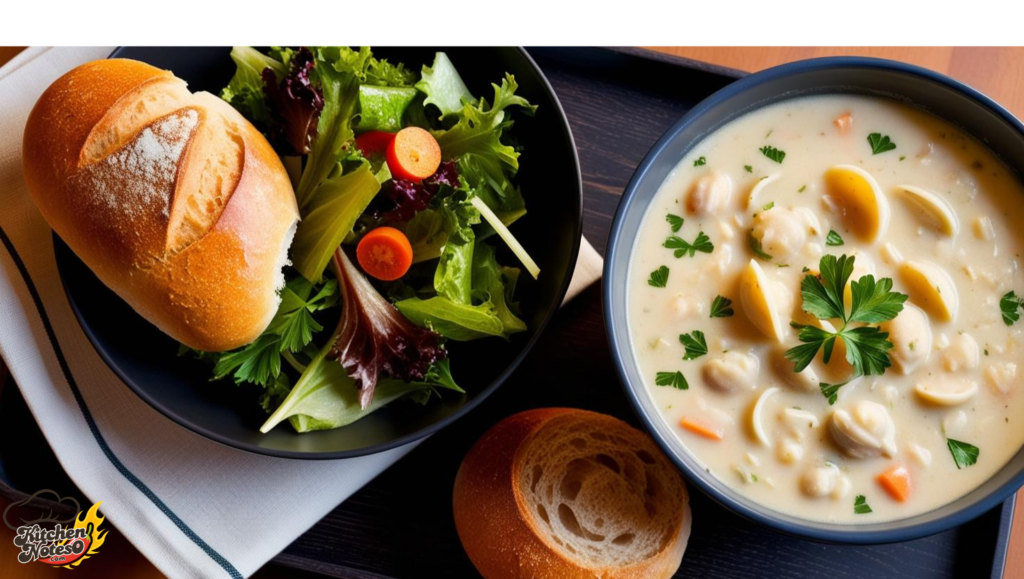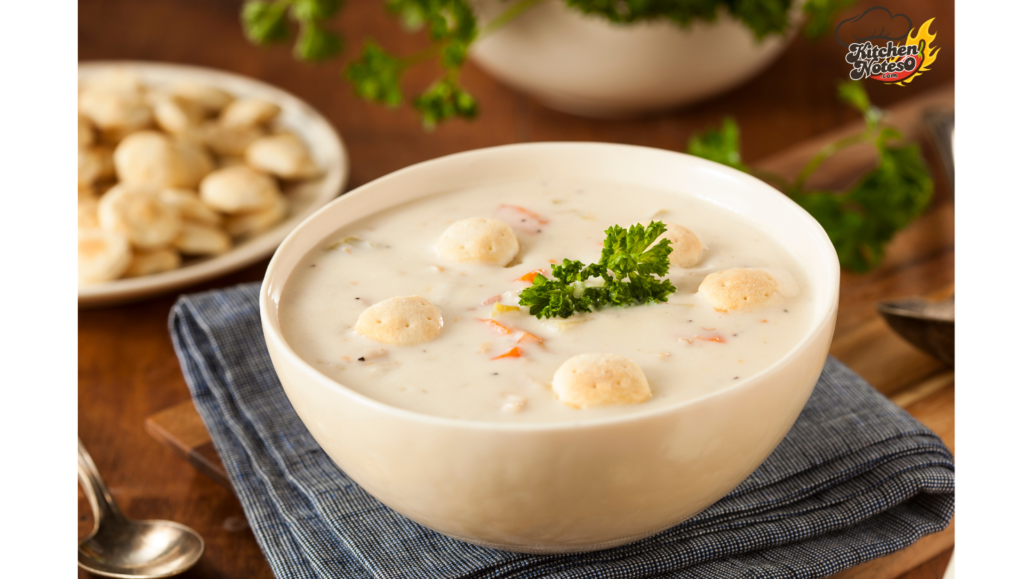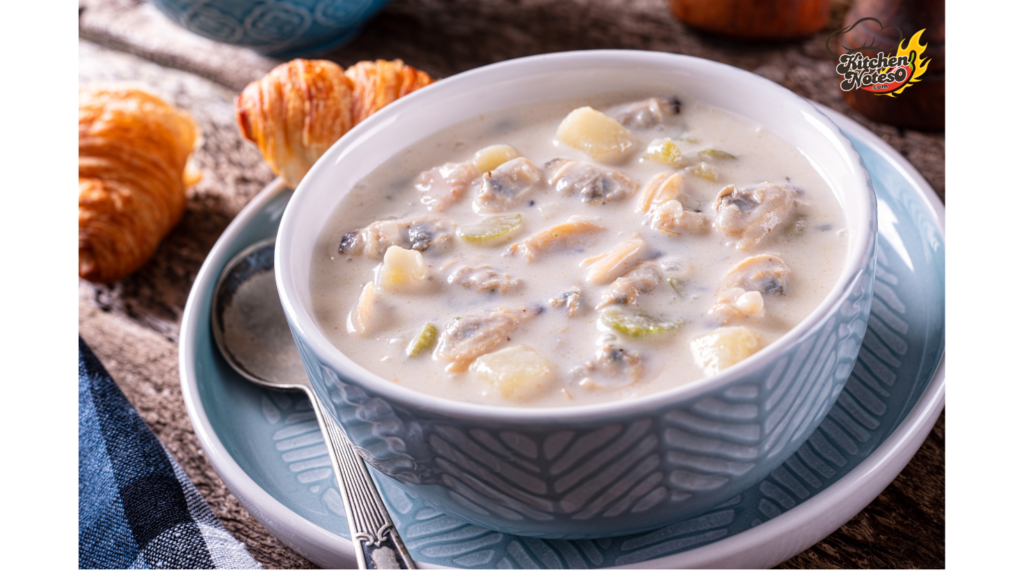
Table of Contents

Introduction
Clam chowder is a hearty and thick soup that has become a favorite in American cooking, especially in the northeastern U.S. It is renowned for its rich taste, tender clams, and creamy consistency, and New England Clam Chowder is a traditional dish that has stood the test of time for centuries.
Whether it is served in diners, coastal restaurants, or residential kitchens, this soup offers both nourishment and a flavor of seaside heritage. In this recipe, we’ll guide you through every step of making a traditional New England-style clam chowder, highlighting key ingredients, prep secrets, and variations along the way to taste.
Whether you’re attempting to replicate a nostalgic favorite or impress guests with a traditional preparation, this guide will allow you to get it just right.

A Short History:
The origin of clam chowder is attributed to the early North American European settlers. French, British, and Portuguese settlers brought their traditions of soup and stew making, which eventually evolved into clam chowder as it is today.
By the 18th century, clams were a staple in coastal regions like New England, where they were abundant and easy to dig up. New England Clam Chowder, characterized by the inclusion of dairy, potatoes, and clams, became popular in the 19th century.
It was most popular in Rhode Island and Massachusetts. Unlike Manhattan Clam Chowder, which is prepared using a tomato base, New England Clam Chowder is characterized by its creamy, milky broth.
Ingredients To Make Clam Chowder
1. Clam and Broth
- 1 cup clam juice (bottled or saved from canned clams)
- 3 cups chopped fresh clams (or 2 cans chopped clams, drained and juices reserved)
- 1.1/2 cups water (if using fresh clams)

2. Soup Base:
- 2 tablespoons unsalted butter
- 1 medium onion (finely chopped)
- 2 cloves garlic (minced)
- 2 stalks of celery (chopped)
- 4 slices thick-cut bacon (diced)
- 3 tablespoons all-purpose flour
- 3 cups peeled and diced potatoes (Yukon Gold or Russet)
- 3 cups peeled and diced potatoes (Yukon Gold or Russet)
- 1/2 teaspoon dried thyme (or 1 tsp fresh thyme)
- 1 bay leaf
- 1 cup heavy cream
- 2 cups half-and-half (or whole milk for a lighter version)
- Salt and freshly ground black pepper, to taste
- Fresh parsley or chives (for garnish)
- A dash of hot sauce or Worcestershire sauce for added depth.
Steps To Make Clam Chowder:
Processing Step for Clam:
- Scrub the clams under cold water to dislodge grit.
- Place them in a pot with 1 1/2 cups of water. Cover and steam over medium heat until the shells open (about 5–7 minutes).
- Discard unopened clams. Remove the meat and chop it up fine. Strain and reserve the cooking liquid through cheesecloth or a fine sieve.

Processing Step for Chowder:
- Fry cubed bacon in a big soup pot or Dutch oven over medium heat until it is crispy. Using a slotted spoon, remove and reserve, leaving drippings behind.
- Add butter to the pot. Cook onions and celery until softened and translucent, about 5 minutes. Add garlic and cook for another 30 seconds.
- Add flour and whisk to form a roux. Cook 1–2 minutes to eliminate the raw flour taste.
- Gradually whisk in clam juice and reserved liquid. Stir constantly to avoid lumps.
- Add potatoes, bay leaf, and thyme. Bring to a boil, decrease heat, and simmer 15–20 minutes or until potatoes are tender.
- Add cream and half-and-half. Stir in clams and cooked bacon. Simmer gently for another 5–10 minutes. Do not boil after adding dairy products.
- Season with salt and pepper to taste. Add a dash of hot sauce or Worcestershire.
- Remove the bay leaf before serving.
Serving Ideas of Clam Chowder:
Serve chowder in bowls and garnish with fresh parsley or chives. You can also serve it with oyster crackers or crusty sourdough bread. It will be tasty just with a sprinkle of paprika or cracked black pepper on top.
Tips for the best Clam Chowder:
- Consistency: Thicken the chowder by mashing potatoes in the pot or by adding another tablespoon of flour.
- Clams: Canned clams of good quality are a simple substitute when fresh clams are not available.
- Flavor Boost: Smoked paprika dashes or a splash of white wine while sautéing vegetables.

Variations:
- Manhattan Clam Chowder: Substitute dairy with tomato juice or crushed tomatoes and add bell peppers and carrots.
- Corn and Clam Chowder: Add 1 cup of corn kernels for a contrasting sweetness.
- Rhode Island Style: Omit dairy for a clear-broth chowder with a brinier taste.
Nutritional Info (Per Serving):
- Calories: 400–450 kcal
- Protein: 25 g
- Carbohydrates: 30 g
- Sodium: 800–900 mg
Conclusion:
New England Clam Chowder is a hearty, creamy, and soothing concoction that represents the essence of coastal life. From its humble beginnings among early settlers to its present incarnation as a gastronomic institution, clam chowder has remained a favorite for centuries.
With its understated mingling of flavors—from smoky bacon to briny clams—it presents layering in every bite. By preparing this recipe and heeding its practical tips, you can create a true clam chowder in your kitchen. Served in a bread bowl or with a side of crackers, this hearty soup brings warmth and taste to any occasion.
For more tips on achieving the perfect texture and flavor, explore our Delicious Chili Con Carne Recipe
Clam chowder is such a classic dish that truly captures the essence of New England. I love how it combines simple ingredients like clams, potatoes, and cream into something so rich and comforting. The history behind it is fascinating too—it’s amazing how it evolved from the traditions of early settlers. I’ve always wondered, though, what makes the perfect clam chowder? Is it the freshness of the clams, the creaminess of the broth, or something else entirely? I’ve tried making it at home, but it never quite tastes like the ones I’ve had in coastal restaurants. Do you think the type of bacon or the cooking time for the potatoes makes a big difference? Also, what’s your take on adding extra herbs or spices—does it enhance the flavor or take away from the traditional taste? I’d love to hear your thoughts or any tips you might have!
Clam freshness matters, but balancing the creamy broth (try clam juice + light cream) is key. Thick-cut bacon adds smokiness, but salt pork keeps it classic. Par-cook potatoes (small cubes!) to avoid mush. A pinch of thyme or bay leaf honors tradition; a dash of smoked paprika adds subtle depth. Simmer and finish with a sherry splash for that “coastal restaurant” vibe. And yes, blame the missing ocean breeze if needed!
Clam chowder sounds like such a comforting dish, especially with its rich history and creamy texture. I love how it ties back to the traditions of early settlers—it’s like a taste of the past in every spoonful. The combination of smoky bacon, tender clams, and creamy broth seems like the perfect balance of flavors. I’m curious, though, do you think the recipe would still work well if I used a plant-based milk instead of dairy? Also, what’s your take on adding extra vegetables like celery or carrots for a bit more depth? I’ve always wondered if that would take away from the traditional taste. And do you have a favorite type of bread to pair with it? I’m thinking sourdough, but maybe there’s something even better. What’s your secret to making it truly unforgettable?
Great questions! Plant-based milk works, go for creamy coconut or cashew milk (just skip the sweetened stuff). Celery’s a classic add, and carrots can sneak in sweetness if diced tiny, no tradish vibes lost. Sourdough’s a solid pick, but toasted rye + smoky bacon = magic. Pro tips: Cook bacon low and slow, use fresh clam juice, and a splash of sherry or fresh thyme at the end. Don’t forget to taste as you go! Let me know how your chowder adventure unfolds. It’s gonna be delicious.